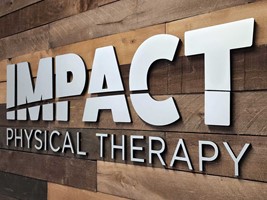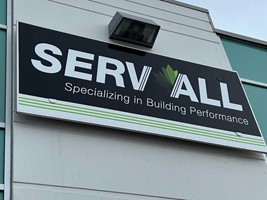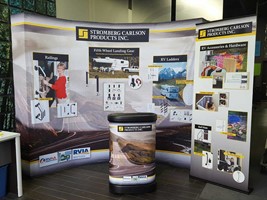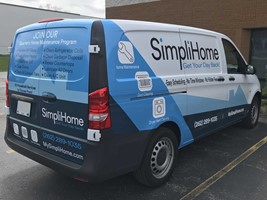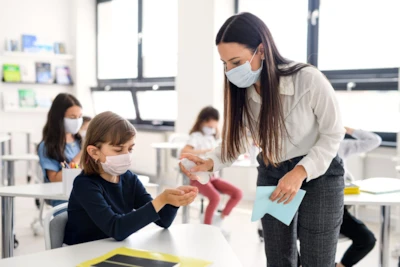
6/23/2020
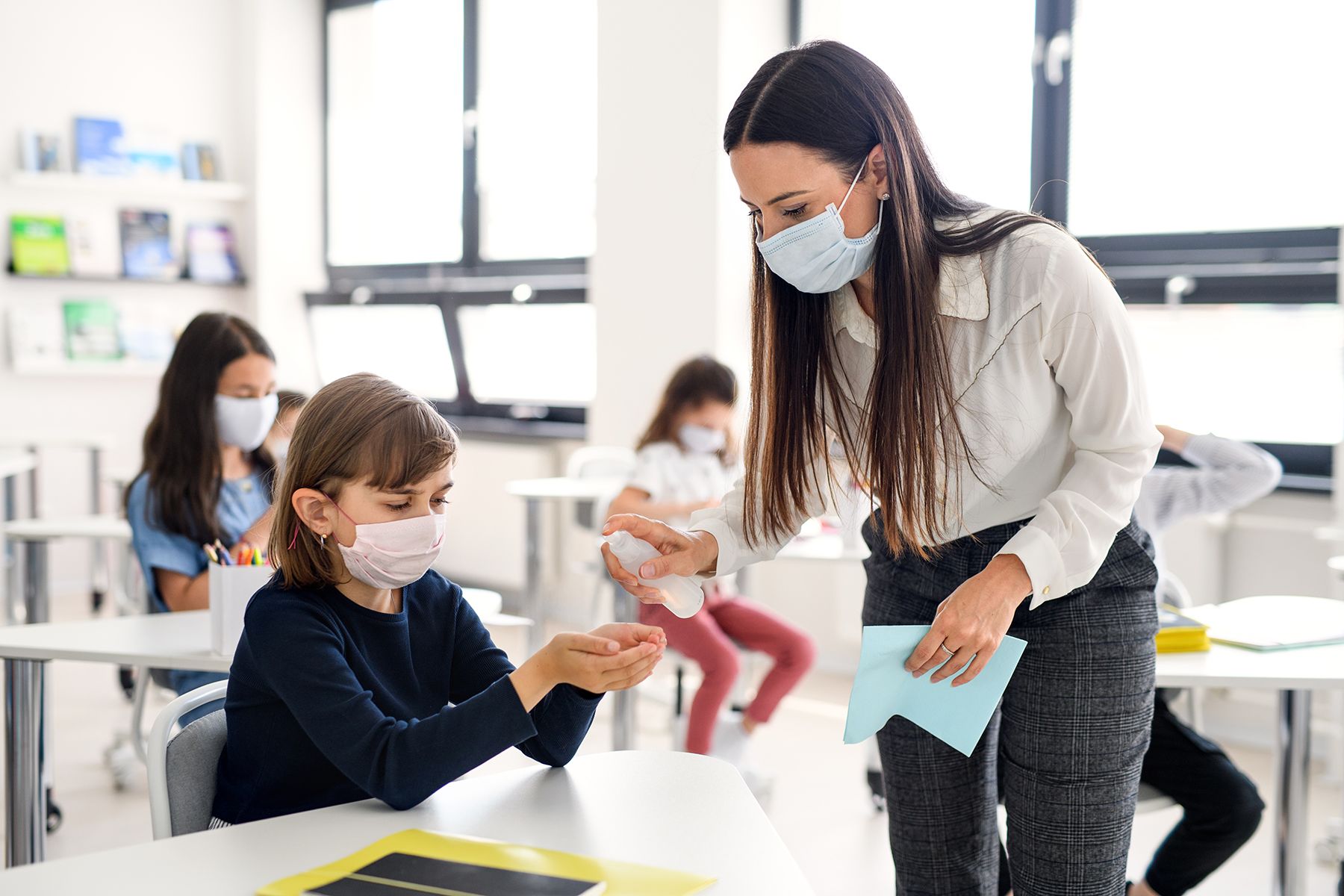
The COVID-19 pandemic has disrupted the lives of students, faculty and education workers across the country. While there is no universal approach to reopening, every school and university, no matter how big or small, has a responsibility to create an environment that feels welcoming and safe for all.
Communication will play an integral part in this, especially environmental communications. Signs and graphics have always been used to provide direction, impart information and inspire new behavior, but in a world adapting to a whole new mode of thinking, they become guiding lights on the pathway to safety.
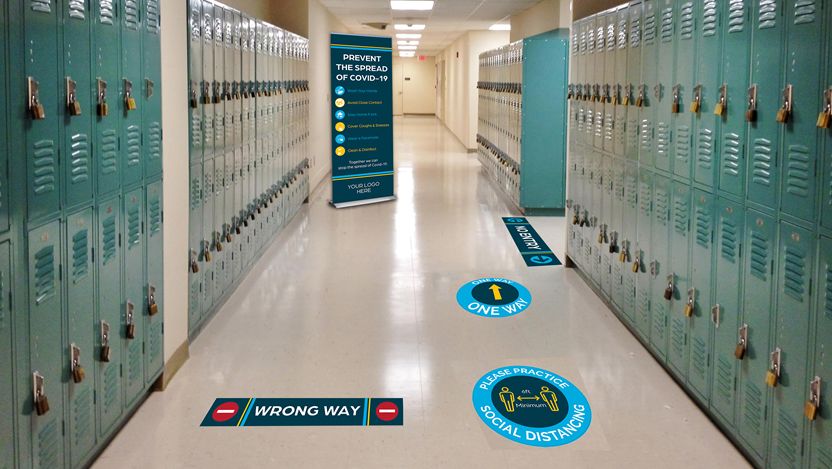
The CDC has provided a useful Schools Decision Tool, which helps administrators make reopening decisions during the COVID-19 pandemic. One thing it makes clear is that before reopening there must be a system in place that will effectively train students and staff to follow hygiene, social distancing and other best practices. Such a system will depend on clear visual communications that catch attention, influence actions and instill confidence.
Every school contains many interrelated environments that each have their own specific requirements. When looking at classrooms, dining areas, gymnasiums, libraries -- and the hallways that connect them all together – having a cohesive communication effort is paramount.
Now is the time for school administrators to assess their environment from a new perspective. Be prepared to adjust furniture, desks and other items, identify safety hazards and opportunities, and install new signs and graphics that facilitate the health and safety of students, visitors, and staff while adhering to public health recommendations.
With that in mind, here are ten key spaces every school should look to upgrade as they lay the groundwork for their reopening:
1. School Exterior
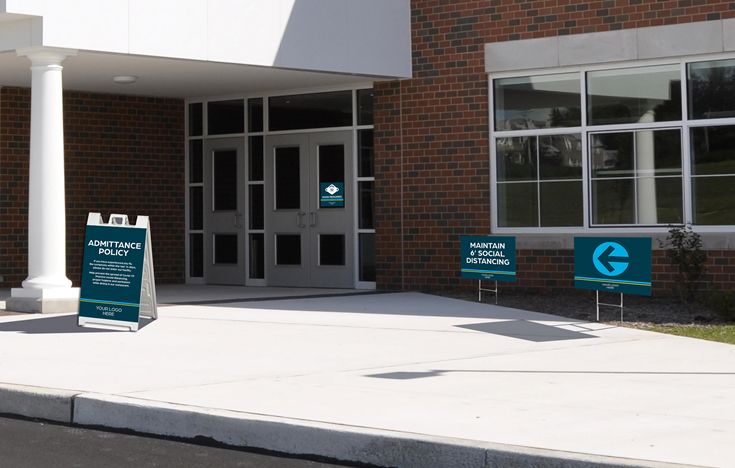
Your school exterior might be one of the most challenging spaces to address with signage. It’s highly visible and the first space students will see as they arrive, so it’s the prime spot to impart vital information. However, you don’t want to overwhelm them with too many competing messages at once. We recommend keeping signage here simple while focusing on the most important messages that will put everyone on the right track.
Yard signs can incorporate directional messages or imagery to point students and staff where they need to go (especially important if the usual access points have changed) or can enforce basic best practices like maintaining six feet social distancing. If you’re enforcing temperature checks upon entry, these can be designated using wayfinding yard signs, pedestal signs and banners.
As students get closer to the main entrance, now is the time to use A-frames and window graphics to communicate more in-depth messaging such as admittance policies, health and hygiene rules or new schedules and procedures.
As you plan these out, think carefully about the normal paths visitors take as they enter the school, and think of your signs as mentors that inspire the right choices on their journey.
2. Lobby
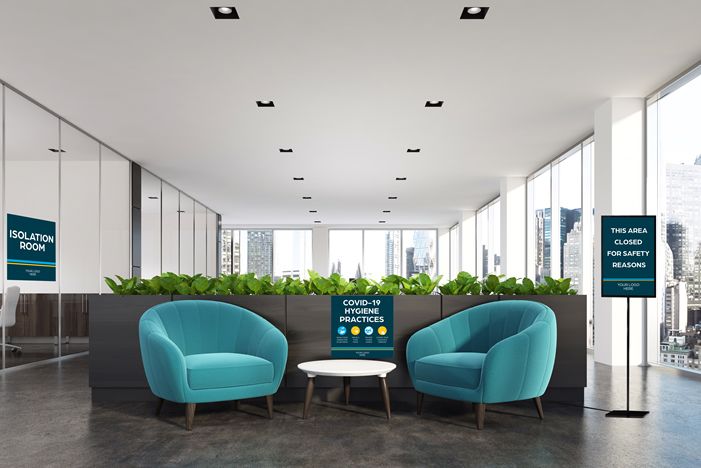
The lobby is an important area to further instill best practices by using graphics and freestanding signs. However, lobbies can easily become overcrowded, which is why you’ll likely need to establish alternating attendance schedules and use signs to maintain safe flow of foot traffic.
Pedestal signs are easily moveable and highly visible, making them great choices for blocking off closed areas, while window graphics can help identify rooms that have a new purpose since class was last in session.
3. Office and Reception

Both staff and students will feel reassured if reception desks and office spaces are properly outfitted with several preventative measures, including hand sanitizer stations, hygiene signs and clear protection screens.
Protection screens can be customized with graphics and lettering, such as words of encouragement, health recommendations or even school branding and mascots.
4. Classrooms and Lecture Halls

There are several different ways your classrooms could be altered to meet local guidelines and facilitate a safer learning environment. Whether rearranging desks, utilizing protection screens, reducing the number of students, or a combination of the above, you’ll require adequate signage to inform everyone of the updated procedures.
In lecture halls and other spaces with many chairs, consider adding graphics or chair covers to clearly designate 6’ social distancing requirements. For rooms that have multiple point for entry, door graphics can be added to denote which ones are for entrance or exit only to minimize cross traffic during class changes.
5. Hallways
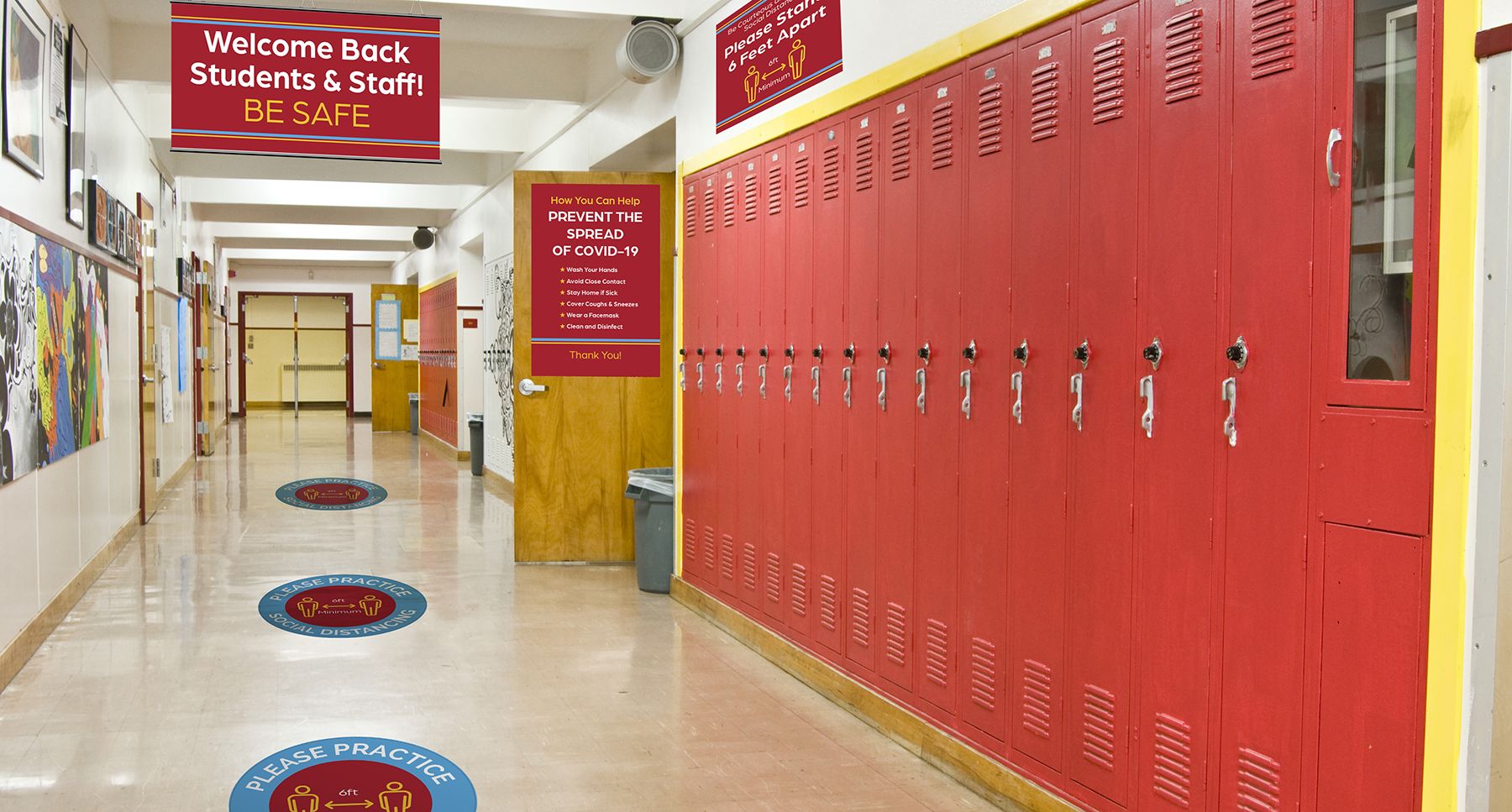
Left to its own devices, a school hallway can easily become a hotbed for interaction and socializing (read: more airborne droplets of coronavirus). Clearly, teachers and staff will need to be extra vigilant in monitoring hallways to ensure students keep their distance and behave responsibly.
Signs and graphics can help maintain order by reminding students of their duties in preventing the spread of germs. Floor graphics will be especially important in enforcing one-way traffic and six foot separation, including marking stairs with arrows to improve the flow of foot traffic.
Amidst all the health and safety guidelines, however, don’t forget to welcome, motivate and celebrate your students. Hallways are ideal for banners that welcome students back, wall graphics that showcase achievements, and routed acrylic signs and plaques for creating Halls of Fame.
6. Restrooms

Restrooms will play an important role in upholding frequent handwashing practices as students return to school. But they also tend to be smaller than most other rooms and will require careful monitoring to ensure they don’t become overcrowded. As always, hygiene and social distancing reminders will help maintain best practices (mirrors are particularly great surfaces for vinyl graphics that can withstand increased amounts of cleaning) with wall-mounted signs being used to enforce proper line etiquette. If possible, create entrance and exit doors (or pathways) for each restroom, reducing the chance that students meet face-to-face.
7. Cafeteria/Dining Halls
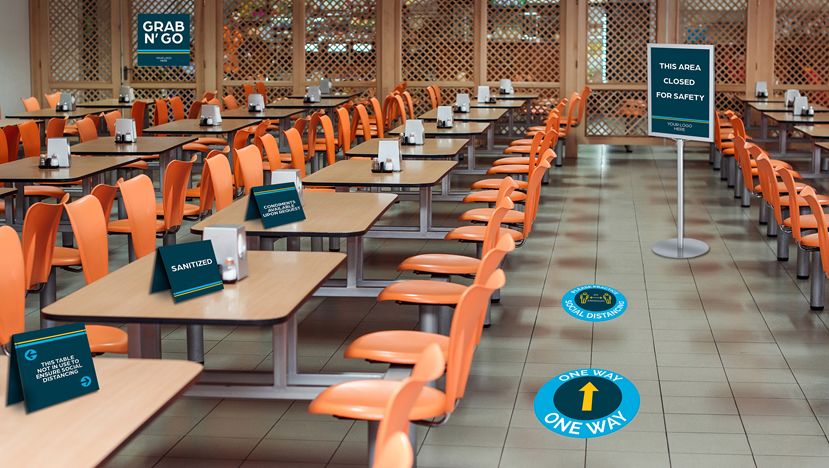
Since cafeterias are traditionally high-traffic social spaces, you’ll need to rethink student access and procedures to maintain a properly sanitized environment. This may mean marking chairs or whole tables as off limits to maintain social distancing.
Freestanding signs and cutouts can be used to mark tables that have recently been sanitized, so students know it’s safe to sit and eat. Of course, hand sanitizer should be readily available throughout the dining area, with clear signs pointing to available stations.
If you’re enforcing the wearing of face masks, keep in mind that students will need to remove them to eat, which makes distancing and other best practices doubly important. You may even consider placing clear protection screens at dining tables to further aid in stopping the spread of COVID-19.
If social distancing is not possible in the cafeteria - or as an additional option for those uncomfortable with eating there – consider delivering meals to classrooms or having students bring food from the cafeteria back to their classrooms. Either way, you’ll need to utilize floor graphics and easy-to-position signs (such as pedestal signs) to help students form safe lines.
8. Library
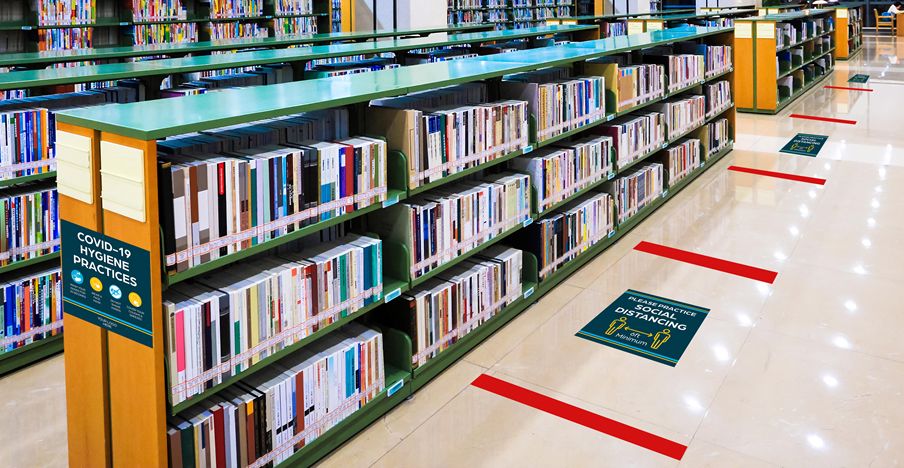
No school wants to limit students’ access to books and given that many students have been studying virtually for several months, they may be in dire need of previously inaccessible resources.
Depending on the size of your library, you may need to free up some space to allow for wider aisles between each bookshelf, so that students can pass one another without making face-to-face contact, or directional graphics to eliminate that potential. Floor graphics will help enforce social distancing in these aisles, while vinyl graphics and freestanding signs at the end of each aisle can further instill safe COVID-19 hygiene practices.
9. Gymnasium/Recreational Facilities
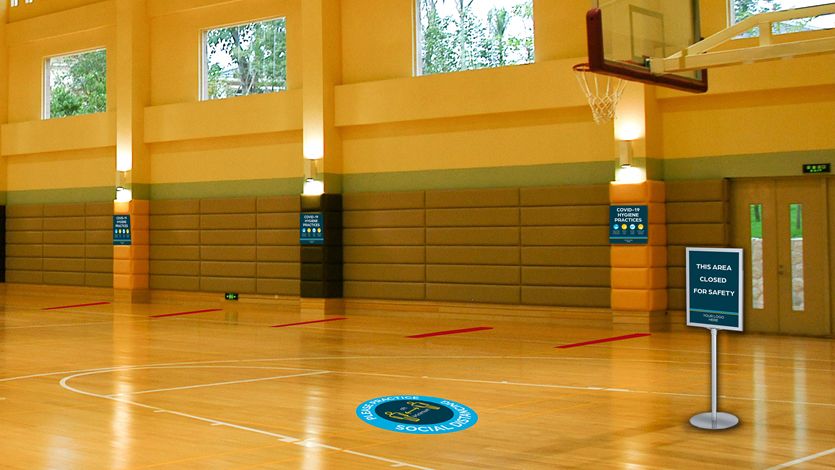
When it comes to your school gym and other exercise spaces, close-contact sports may not be an option anytime soon. However, socially distanced exercise regimes and even some no-contact sports could be reinstated safely. Floor graphics will need to be more prominent and attention-grabbing than ever, especially if they’re to compete with pre-existing floor decals.
Since your recreation spaces may be used for other functions during the coming months, you’ll want to incorporate signs that can be easily moved to meet different needs, such as free-standing pedestal signs and A-frames.
10. Transportation
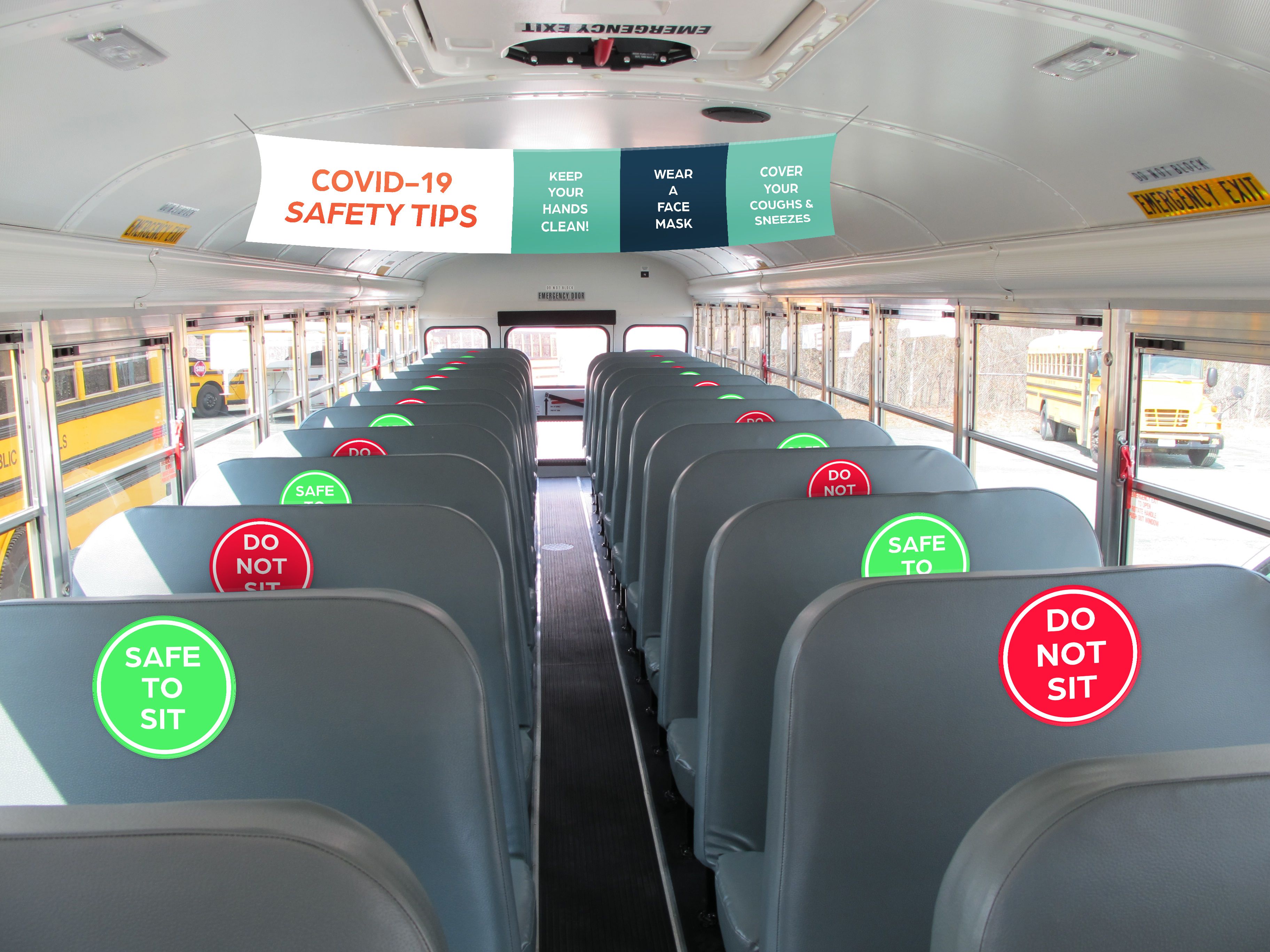
In order for parents and children to feel comfortable with school buses again, strict measures will need to be in place, particularly mask-wearing, social distancing routine temperature checks and frequent deep cleans. All of these can be enforced through signs that remind each student and staff member of their responsibilities. Even the exterior of each bus may include graphics that remind students and passersby to keep their distance.
If you have vehicles that stay on-campus – such as security cars – these may also benefit from upgraded graphics that speak to current safety measures and guidelines.
We know that every education space is unique and will face its own set of challenges. That’s why we we’re here to discuss solutions for not only these handful of ideas, but other areas you may be thinking about as well -- including adding room dividers to media centers and computer labs or setting up safe table displays for spelling bees and parent evenings.
By building an integrated signage system that creates safe yet flexible learning environments, you’ll help students and parents feel confident coming back into schools, while faculty and staff will be able to excel at their jobs stress-free.
Interested to learn more? Download our reopening checklist below for a full list of communication strategies to follow as you reopen your school.
|
 Contact us today to set up a virtual meeting to discuss your specific needs.
Contact us today to set up a virtual meeting to discuss your specific needs.
Image360 is ready to help you as you prepare to reopen your school safely, and it all begins with a consultation with our visual communications experts. With a Free Re-opening Safety Evaluation, we'll review your school or campus to help ensure it conforms to recommendations and guidelines from local and national authorities. We’ll discuss the needs of your business, make safety strategy recommendations, and assist with all aspects of production and installation.



